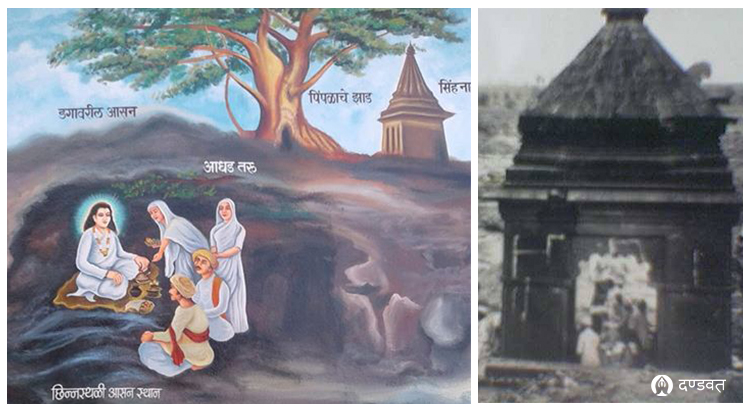Glory of the Mahatirth Asan Chinsthali, one of the oldest and the mahasthan of Mahanubhava Pantha

🙏 Dandvat Pranam 🙏
All of us know that about the Mahatirth Asan Chinsthali, yes the same which one is taking a great turn in the present time. One of the most historical and the Pujniye and the Holy place of the Mahanubhava Pantha, we call this as the Tirath Sthan. The Mahatirth Asan Chinsthali, is on the bank of the Godavari river.
Regarding the time of construction of Mahatirth Asan Chinsthali, there is no perfect and the accurate time. Stil we have a statement that Harku Bai Holkar, who was savat of Ahilia Bai Holkar. They said it was constructed in the times of 17th century and in between. No accurate time is available. So collecting the few from history and few from the our Mahanubhav Pantha promoter i.e Mahatma Raghavbhat Satarkar.
Truly said, Muni Ji is the man behind the renovation and the construction of the Stone Temple. From their tireless and the continuous effort, the Tirath Sthan is once in the better position than before.
The structure is proposed by the SOCIETY FOR ASAN CHINSTHALI DEVELOPMENT AND MAINTENANCE (SADAN). Now, there is a message from the Panth Promoter Mahatma Raghavbhat Satarkar regarding the Mahatirth Asan Chinsthali.
🙏 जय श्री कृष्ण जी 🙏
All of us know that about the Mahatirth Asan Chinsthali, yes the same which one is taking a great turn in the present time. One of the most historical and the Pujniye and the Holy place of the Mahanubhava Pantha, we call this as the Tirath Sthan. The Mahatirth Asan Chinsthali, is on the bank of the Godavari river.
Regarding the time of construction of Mahatirth Asan Chinsthali, there is no perfect and the accurate time. Stil we have a statement that Harku Bai Holkar, who was savat of Ahilia Bai Holkar. They said it was constructed in the times of 17th century and in between. No accurate time is available. So collecting the few from history and few from the our Mahanubhav Pantha promoter i.e Mahatma Raghavbhat Satarkar.
Truly said, Muni Ji is the man behind the renovation and the construction of the Stone Temple. From their tireless and the continuous effort, the Tirath Sthan is once in the better position than before.
The structure is proposed by the SOCIETY FOR ASAN CHINSTHALI DEVELOPMENT AND MAINTENANCE (SADAN). Now, there is a message from the Panth Promoter Mahatma Raghavbhat Satarkar regarding the Mahatirth Asan Chinsthali.
🙏 जय श्री कृष्ण जी 🙏
🙏 दंडवत प्रणामनमो पंच कृष्ण अवतार
- Author: Dandvat
- Posted on: September 30, 2016 8:00 AM
- Tags: Mahanubhav Pantha, Shree Chakrdhar Swami, Mahanubahv Tirath Sthan, Knowing Mahanubhav Pantha, Mahanubahv Panch Avatar
